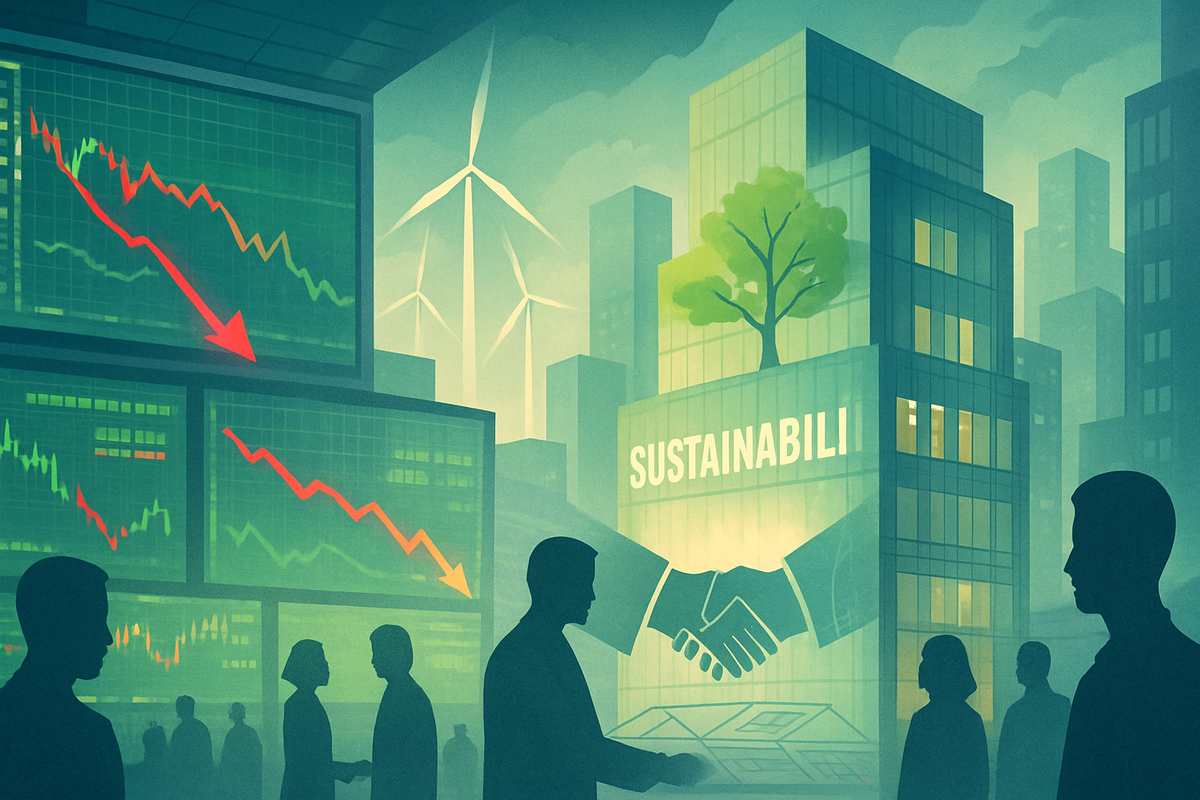
As of October 16, 2025, the landscape of Environmental, Social, and Governance (ESG) investing in the United States presents a complex picture of contrasting trends. While global sustainable funds have seen a rebound in inflows, US-domiciled ESG funds have endured a prolonged period of net outflows, extending for 10 to 11 consecutive quarters. This divergence highlights a unique challenge within the US market, where political headwinds and regulatory uncertainty are influencing investor behavior, even as corporate commitment to sustainability initiatives remains robust.
Despite these significant outflows, the underlying growth trajectory and strategic importance of ESG investing are undeniable. Assets under management in US sustainable funds continue to grow, driven by market appreciation, and long-term projections anticipate substantial revenue growth in the sector. This creates a fascinating dynamic where short-term investor sentiment, influenced by external pressures, appears to be at odds with the enduring business case for sustainability and the long-term capital flows expected to shape future financial markets.
A Deep Dive into US ESG Fund Dynamics
The persistent net outflows from US-domiciled sustainable funds represent a defining characteristic of the current ESG investment climate. In the first quarter of 2025, these funds experienced $6.1 billion in outflows, followed by an additional $5.7 billion in the second quarter. This continues a trend observed throughout 2023 and 2024, which saw $13.3 billion and $19.6 billion in net outflows, respectively. More recently, as of August 2025, funds explicitly investing in ESG criteria recorded a net outflow of $1.70 billion, underscoring the ongoing challenge.
This trend stands in stark contrast to global patterns, particularly in Europe, where sustainable funds saw a healthy rebound with $8.6 billion in inflows during Q2 2025. Globally, sustainable fund assets reached $3.5 trillion by June 2025, up nearly 10% in just three months. The divergence points to a significant impact of regional regulatory environments and political discourse on investor confidence in ESG products. A key event leading up to this moment was the formal withdrawal of the SEC's proposed rule on ESG disclosures for investment advisers and funds in June 2025, signaling a broader regulatory pullback that likely contributed to investor caution.
Key players in this evolving landscape include major asset managers like BlackRock (NYSE: BLK), Vanguard, and State Street (NYSE: STT), who have been at the forefront of offering ESG products but are now navigating a more scrutinized environment. Corporate executives, as stakeholders, continue to prioritize sustainability for competitive advantage, with 87% of large US companies maintaining or increasing ESG investments in 2025. However, many are publicly downplaying these efforts due to the "anti-ESG" rhetoric. The initial market reaction has been a slowdown in new sustainable fund launches in the US, with only 10 in 2024—the lowest in a decade—and fund closures now outnumbering new introductions, reflecting increased caution and greenwashing concerns.
Companies Navigating the ESG Crosscurrents
The current ESG investment trends create a bifurcated environment, presenting both significant opportunities and challenges for public companies. Companies with robust and genuinely integrated ESG strategies, particularly those that can demonstrate tangible impact and financial returns, are poised to be long-term winners. Conversely, those that have engaged in superficial "greenwashing" or fail to adapt to evolving sustainability demands may face increasing scrutiny and investor divestment.
Potential Winners: Companies demonstrating strong commitments to climate change mitigation, clean energy innovation, and social equity are likely to attract capital over the long term, despite current US fund outflows. For instance, renewable energy companies such as NextEra Energy (NYSE: NEE) or Vestas Wind Systems (CPH: VWS) stand to benefit from the sustained focus on clean energy themes. Technology companies that provide solutions for sustainable operations, like Schneider Electric (EPA: SU) or Siemens (ETR: SIE), could also see increased demand. Furthermore, companies with strong governance structures and transparent reporting, like Microsoft (NASDAQ: MSFT) with its extensive sustainability initiatives, are better positioned to weather regulatory shifts and maintain investor trust. These firms often see sustainability as a driver of competitive advantage, operational efficiency, and risk reduction, which are increasingly valued by institutional investors.
Potential Losers: Companies heavily reliant on fossil fuels or those with poor environmental and social records may face continued pressure. Traditional energy companies, particularly those without credible transition plans, could see their cost of capital rise and investor base shrink as exclusionary screening remains a dominant ESG strategy. For example, some smaller, undiversified oil and gas producers might struggle to attract capital. Companies implicated in significant environmental controversies or labor disputes, or those with opaque governance, are also at risk. The current political climate, while seemingly anti-ESG, paradoxically reinforces the need for genuine sustainability efforts, as companies that merely pay lip service to ESG without fundamental change are more susceptible to accusations of greenwashing and subsequent investor backlash. Asset managers that have launched numerous ESG funds without clear differentiation or measurable impact may also face consolidation pressures due to the net outflows and increased scrutiny.
Wider Significance and Industry Transformation
The current trends in US ESG investing are not isolated events but rather integral to broader industry transformations. The divergence between US outflows and global inflows underscores the profound impact of regulatory clarity and political stability on capital allocation. In Europe, where regulatory frameworks like the Sustainable Finance Disclosure Regulation (SFDR) provide a more defined landscape, investors appear more confident in sustainable products. This contrast suggests that a lack of consistent policy and the "anti-ESG" rhetoric in the US are creating an environment of uncertainty that deters investment in dedicated ESG funds, even if corporate sustainability efforts continue behind the scenes.
This phenomenon has significant ripple effects. Competitors in the asset management space are adapting by either de-emphasizing the "ESG" label in their US offerings or by focusing on broader sustainability themes that are less politically charged. Partners, such as data providers and rating agencies, face increased demand for more robust, transparent, and measurable ESG data to address greenwashing concerns and demonstrate genuine impact. The regulatory implications are profound; the SEC's withdrawal of proposed ESG disclosure rules signals a cautious approach from US regulators, potentially leading to a patchwork of state-level initiatives or a reliance on voluntary corporate disclosures. Historically, similar periods of regulatory uncertainty or political pushback have often preceded a more mature and refined approach to investment criteria, as seen with the evolution of socially responsible investing (SRI) over decades. This current phase could be a crucible for the next generation of sustainable investment strategies, demanding greater rigor and demonstrable impact.
What Comes Next: Navigating the Evolving ESG Landscape
The path forward for ESG investing in the US is likely to be characterized by both continued challenges and emerging opportunities. In the short term, the political climate is expected to remain a significant factor, potentially leading to further caution from asset managers in overtly marketing ESG products. We may see a strategic pivot towards "sustainability-themed" or "impact-oriented" funds rather than those explicitly labeled "ESG," aiming to appeal to a broader investor base while sidestepping political sensitivities. Fund closures and consolidation among less differentiated ESG offerings are also probable.
Long-term possibilities, however, paint a more optimistic picture. The underlying drivers of ESG demand—increasing investor awareness (especially among millennials and Gen Z), rising corporate commitment to sustainability as a business imperative, and global policy pressures—are expected to fuel growth. The US SIF Trends Report 2024/2025 projects significant growth in the sustainable investment market over the next 1-2 years, driven by client demand, evolving regulatory frameworks (despite current setbacks), and advancements in data analytics. This suggests that the current outflows may be a temporary recalibration rather than a fundamental rejection of sustainable investing. Market opportunities may emerge in areas like sustainable fixed income, which has already achieved significant scale ($6 trillion outstanding globally), and private markets, where embedding sustainability can enhance performance and exit multiples. Companies that can effectively integrate AI and advanced analytics to provide clearer, more verifiable ESG data will also find a significant market. Potential scenarios include a gradual re-emergence of clearer federal guidance post-election, or a continued reliance on state-level initiatives and voluntary corporate standards, which would necessitate greater due diligence from investors.
A Comprehensive Wrap-Up: Resilience Amidst Headwinds
The current state of ESG investing in US fund flows is a testament to its resilience amidst significant headwinds. While the persistent net outflows from US sustainable funds present an immediate challenge, they mask a deeper, unwavering corporate commitment to sustainability and a strong long-term growth trajectory for the broader sustainable investment market. Key takeaways include the profound impact of political and regulatory environments on investor behavior, the growing divergence between US and global ESG fund flows, and the critical need for transparent, measurable impact from sustainable investments to counter greenwashing concerns.
Moving forward, the market will likely see asset managers and corporations adapting their strategies, potentially by refining their communication around sustainability, focusing on demonstrable outcomes, and leveraging advanced data analytics. Investors should watch for shifts in the regulatory landscape, particularly after upcoming election cycles, as well as the continued evolution of corporate sustainability practices. The current period, while turbulent, may ultimately strengthen the foundation of ESG investing by demanding greater rigor, transparency, and genuine impact, ensuring its lasting significance in shaping future financial markets.
This content is intended for informational purposes only and is not financial advice





